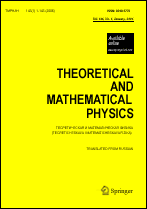|
This article is cited in 1 scientific paper (total in 1 paper)
From the Wigner function to the $s$-ordered phase-space distribution via a Gaussian noise channel
Yue Zhangab, Shunlong Luocd
a Beijing Academy of Quantum Information Sciences, Beijing, China
b State Key Laboratory of Mesoscopic Physics, School of Physics, Frontiers Science Center
for Nano-optoelectronics, Peking University, Beijing, China
c Academy of Mathematics and Systems Science, Chinese Academy of Sciences, Beijing, China
d School of Mathematical Sciences, University of the Chinese Academy of Sciences, Beijing, China
Abstract:
Various phase-space distributions, from the celebrated Wigner function, to the Husimi $Q$ function and the Glauber–Sudarshan $P$ distribution, have played an interesting and important role in the phase-space formulation of quantum mechanics in general, and quantum optics in particular. A unified approach to all these distributions based on the notion of the $s$-ordered phase-space distribution was introduced by Cahill and Glauber. With the intention of illuminating the physical meaning of the parameter $s$, we interpret the $s$-ordered phase-space distribution as the Wigner function of a state under the Gaussian noise channel, and thus reveal an intrinsic connection between the $s$-ordered phase-space distribution and the Gaussian noise channel, which yields a physical insight into the $s$-ordered phase-space distribution. In this connection, the parameter $-s/2$ (rather than the original $s$) acquires the role of the noise occurring in the Gaussian noise channel. An alternative representation of the Gaussian noise channel as the scaling-measurement preparation in a coherent states is illuminated. Furthermore, by exploiting the freedom in the parameter $s$, we introduce a computable and experimentally testable quantifier for optical nonclassicality, reveal its basic properties, and illustrate it by typical examples. A simple and convenient criterion for optical nonclassicality in terms of the $s$-ordered phase-space distribution is derived.
Keywords:
Wigner function, $s$-ordered phase-space distribution, Gaussian noise channel, noise parameter, nonclassicality.
Received: 20.08.2021
Revised: 26.10.2021
Citation:
Yue Zhang, Shunlong Luo, “From the Wigner function to the $s$-ordered phase-space distribution via a Gaussian noise channel”, TMF, 210:3 (2022), 485–504; Theoret. and Math. Phys., 210:3 (2022), 425–441
Linking options:
https://www.mathnet.ru/eng/tmf10164https://doi.org/10.4213/tmf10164 https://www.mathnet.ru/eng/tmf/v210/i3/p485
|


| Statistics & downloads: |
| Abstract page: | 186 | | Full-text PDF : | 38 | | References: | 48 | | First page: | 11 |
|




 Contact us:
Contact us: Terms of Use
Terms of Use
 Registration to the website
Registration to the website Logotypes
Logotypes







 Citation in format
Citation in format 
